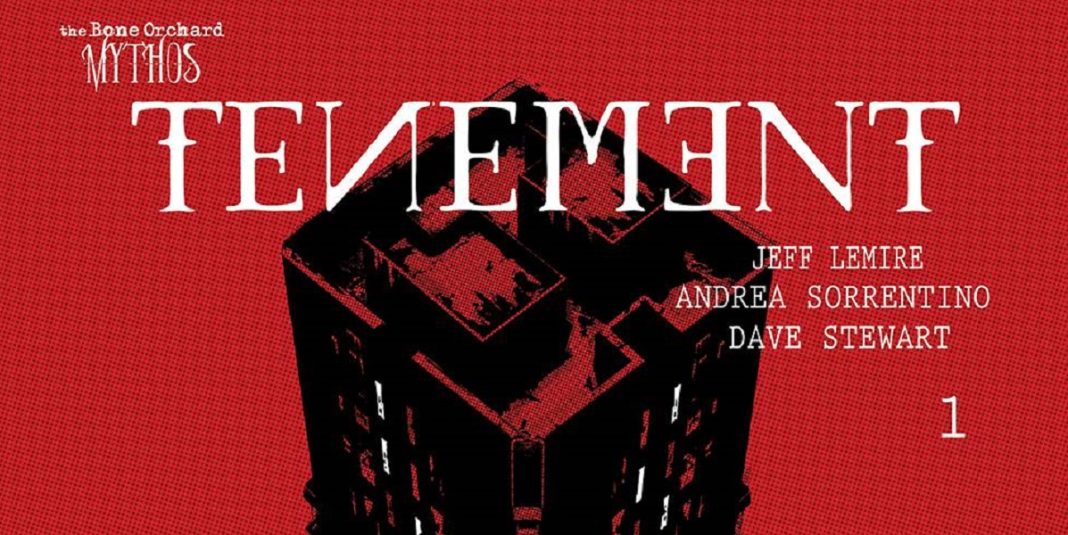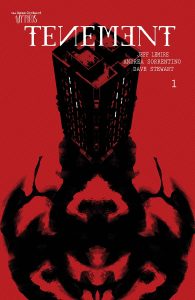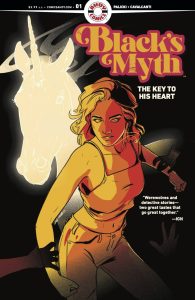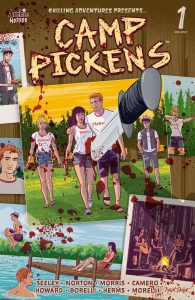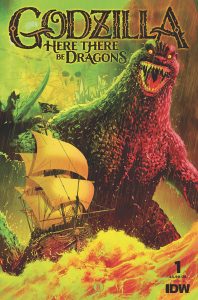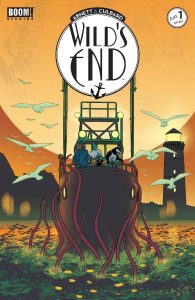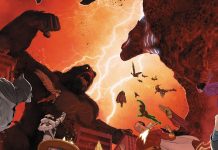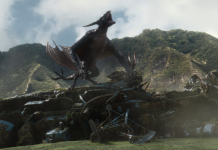This week’s lead review is Bone Orchard Mythos – Tenement #1, which expands Jeff Lemire and Andrea Sorrentino’s ongoing horror shared universe. Plus, the Wednesday Comics Team has its usual rundown of the new #1s, finales and other notable issues from non-Big 2 publishers, all of which you can find below … enjoy!
 Bone Orchard Mythos – Tenement #1
Bone Orchard Mythos – Tenement #1
Writer: Jeff Lemire
Artist: Andrea Sorrentino
Colorist: Dave Stewart
Letterer & Design: Steve Wands
Publisher: Image Comics
For the uninitiated, the Bone Orchard Mythos is a shared horror universe from writer Jeff Lemire and artist Andrea Sorrentino, with colors by Dave Stewart and letters by Steve Wands. It launched last year with a graphic novel, The Passageway, and then was followed up in September with the first issue of a miniseries, Ten Thousand Black Feathers. So far, the connections between these stories have been as subtle and mysterious as the horror in the books itself. Admittedly, I haven’t given any of the material a second, close read, but my sense is that the main connection between the books is the shared aesthetic, powered by Sorrentino’s interesting and spooky perspectives and experimental layouts.
This week, we get Tenement #1, another building block in the world. It’s a comic that feels similar to the rest of the Bone Orchard Mythos books, but also different with the type of story it tells. This book is built on an ensemble cast living in the same tenement building, where — of course — something supernatural, terrifying, and mysterious is at play.
Sorrentino’s aforementioned bold panel layouts are a natural fit for an ensemble cast. He’s able to deftly break pages up to feature multiple characters in different places within the building, giving the reader a sense that they’re all going through something shared together. It works well, with the titular Tenement as a nice anchor for the storytelling.
Then, of course, the book trades largely in mystery, not revealing much of anything that’s going on here or why, but serving up plenty of top-tier horror visuals. I’ve liked all the books in this shared universe so far, and with this one, I’m really appreciating the variety in the types of narratives they’re tackling. I really enjoyed Ten Thousand Black Feathers, which had a hyperfocus on basically two characters and the bond between them over time. This book is a whole other thing, but the artwork and storytelling approach gives us unity between the two.
And I think that’s the strength and wisdom behind the Bone Orchard Mythos overall. These stories don’t need to be overtly connected or blending. The shared universe feel is propagated so well by the work Sorrentino is doing on all these books, that that’s the unifier, and it’s a very strong one.
Verdict: BUY
Wednesday Comics Reviews
Black’s Myth – The Key to His Heart #1 (AHOY COMICS): Black’s Myth comes back for a new series as writer Eric Palicki, artist Wendell Cavalcanti, and letterer Rob Steen revisit Strummer and Ben, as they take on a new case that isn’t what it seems involving a girl, Carly, who isn’t what she seems. The creative team works to expand the world and build off of the established supernatural happenings from their initial run and dive back into the lives of our supernatural detectives with witty dialogue, clean page layouts, and great art with strong compositions and contrast. They work to take a big moment and really blow it up when a grid functions as the norm across many of the pages. The use of splash pages is excellent and well timed and really locks the eye in place with big or establishing moments. Following Black’s Myth, there are two short prose stories “Like a Fish in the Night” by Sam Share and “Foot Fault” by Dave Giarrusso; one a noir parody and the other an ironic story. —Khalid Johnson
- Chilling Adventures Presents… Camp Pickens #1 (ARCHIE COMICS): Right up top I want to say that conceptually I am a huge fan of this one-shot. Midsummer is the perfect timing for an issue about Riverdale’s sleep-away summer camp, and what embodies the apotheosis of said camp more completely that ghost stories around the campfire? This anthology returns to the frame story format, with “Bug Juice” by Jordan Morris and Diana Camero providing the service for the issue. Offering an unusual explanation and origin for the eponymous beverage, this is tale nails the creeps. Plus, the conclusion is smirk-worthy (in the best way). The second story is “The Curse of Camp Pickens” by Blake Howard and Carola Borelli. This one pulls together a few persistent camp myths together in a clever manner. I liked the way it was punctuated by the final panel. Finally, “Down and Out and Death Cursed” by Tim Seeley and Mike Nortonoffers a fun back-and-forth between Veronica and the Pickens Puncturer. This story leaves you guessing, giggling, and gasping all the way through. It’s all colored by Matt Herms and lettered by the legendary Jack Morelli. With a main cover by Matt Talbot and a variant cover by Francesco Francavilla, this is another solid Archie Horror anthology in the books. Say, are we ever going to get a Horror Digest that reprints a selection of these short stories in my favorite, purse-sized Archie format? – Avery Kaplan
Godzilla: Here There Be Dragons #1 (IDW Publishing): Here there also be a romping fantasy fiction braided into the fabric of historical events. When done well, these are some of my favorite stories and this 5-issue miniseries is off to a skreeonking great start. Before his public hanging, an unrepentant buccaneer with a list of charges Jack Sparrow would admire bargains for a drink and his freedom in exchange for information. The yarn he spins includes legendary fortunes of a dead bishop, Sir Francis Drake, and a terrible dragon standing vigil over a vast pirate treasure. Whether his tale will be enough to spare the life of our narrator remains to be seen, but as crafted by writer Frank Tieri and artist Inaki Miranda, it certainly draws the reader into an Age of Sail iteration of Godzilla. They do a believable hopscotch through 14th and 16th century events framing their tale, and peppering in real historical personages, minor to major, famous to infamous, lends credibility. Perhaps it’s detail overkill for past adventures of an atomic age kaiju, but it sells the concept beautifully. Godzilla is exactly the sort of creature ancient cartographers had in mind when they lettered warnings in the unexplored corners of their maps. The lost treasure angle comes off not only as tantalizing as any proposed by the Oak Island Mystery, but infinitely more perilous.Questions remain regarding if this Godzilla is the one we know, simply in an earlier stage of his long life prior to being awakened by nuclear experimentation. Or if it’s a variant occupying a different reality altogether. It’s mentioned that the terrible dragon guarding the lost island breathes fire, which sounds both like dragons of myth but also like fiery cones of atomic breath, definitely a later development. In lesser hands, such a fusion might have come off clumsy and forced, but this creative team makes it intriguing. Tieri and Miranda, plus colorist Eva de la Cruz and letterer Nathan Widick, deliver an elegant, promising start to a unique miniseries. For readers who can sail past the traditional atomic age metaphors the Godzilla legend normally embodies and into unchartered waters, it offers exploration of the familiar King of the Monsters through a very different historical lens. –Clyde Hall
Wild’s End #1 (Boom Studios): Returning to a countryside I’ve never known would be a feat if not for the impeccable charm of I.N.J. Culbard’s art and the wry cadence of Dan Abnett’s writing. It’s a familiar enough setup to jump onto: a seaside town, realism drenched cartoon animal townsfolk, some easy wants/needs, some conflicting variables, and a dash of Twilight Zone style sci-fi weird. Wild’s End #1 plays an unnoticeable trick of immersing through careful pacing. Abnett keeps the cast’s lifestyles large enough to be three-dimensional and their conversations pared down enough to feel one-dimensional. You can easily slide right into the lives of Gullstone Harbour folk from this alone, but Culbard’s layouts keep the pace feeding steadily as each page clocks in at six panels each, set in up to three rows. Very rarely straying from this visual rhythm, Wild’s End #1 is a quaint, enjoyable ride with some lingering doubts and double-takes built in to intrigue, but never smacking the readers with a jarring reveal or plot twist.Culbard’s colors harken back to 1950s palettes, but with a warming red shadow to provide some pop amid the ocean horizon gradients that exist as a backdrop to this particularly Whovian setup. Not short on tricks, Culbard finds a way to letter a garbled, otherworldly voice in such a way that we instantly doubt if the cast is hallucinating or lucid. Aside from the repeated use of no-tail balloons that don’t vary in color or font to act as droning radio speak we’ll glaze over, Culbard’s lettering knows where to punch up and where it’s best left alone. If simple, rewarding, immersive-heavy weird sci-fi is up your alley, then by all means! —Beau Q.
Read more entries in the Wednesday Comics reviews series!


